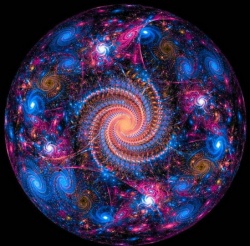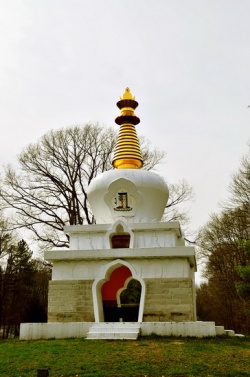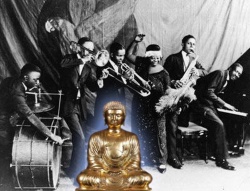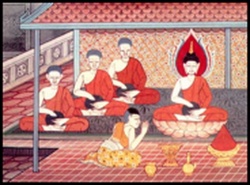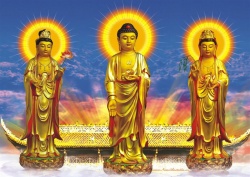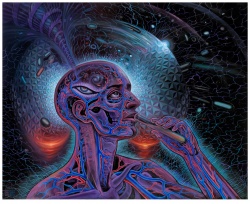Illusory body
illusory body (gyu-lu, sgyu lus) A subtle body generated through practice of the completion stage of Highest Yoga Tantra; the cause of the rupakaya.
The subtle divine body that is principally developed from the indestructible wind.
When a practitioner of Highest Yoga Tantra rises from the meditation of the isolated mind of ultimate example clear light, he or she attains a body that is not the same as his or her ordinary physical body.
This new body is the illusory body. It has the same appearance as the body of the personal Deity of generation stage except that it is white in colour. It can be perceived only by those who have already attained an illusory body
Through intensive, deep meditation practice, it is possible to achieve an illusory body (sgyu-lus).
This is the result of extremely advanced complete stage (rdzogs-rim, completion stage practice in the highest class of tantra, anuttarayoga.
It is with this body that one gains the nonconceptual realization of voidness with a clear light subtlest mind.
In this form, it is possible to travel extensively outside the limitations of one’s physical body, working for the benefit of others.
In order to attain an illusory body, it is necessary to have achieved beforehand renunciation of suffering, a bodhichitta aim to achieve Buddhahood in order to be able to help all others achieve the same, and a correct conceptual understanding of voidness.
In addition, one must have attained single-pointed absorbed concentration (ting-nge-‘dzin, Skt. samadhi), received the proper tantric empowerments from a fully qualified tantric master, kept all the vows purely, and attained proficiency in the generation stage (bskyed-rim) and the initial complete stage practices of anuttarayoga tantra.
The physical body is sometimes referred to as an illusory body, because it is ultimately unreal, and impermanent, but the term "illusory body" also refers to a body of divine light which is created towards the end stages of the completion practices.
Through intensive, deep meditation practice, it is possible to achieve an illusory body (sgyu-lus).
This is the result of extremely advanced complete stage (rdzogs-rim, completion stage practice in the highest class of tantra, anuttarayoga.
It is with this body that one gains the nonconceptual realization of voidness with a clear light subtlest mind.
In this form, it is possible to travel extensively outside the limitations of one’s physical body, working for the benefit of others.
In the completion stage of Buddhist Tantra, the practitioner takes on the form of a deity in an illusory body (mayadeha).
It is made of wind, or prana, and is called illusory because it appears only to other yogis who have also attained the illusory body. The illusory body has the markings and signs of a buddha.
There is an impure and a pure illusory body, depending on the stage of the yogi's practice.
There are three different stages of practice in three different systems of buddhist tantra represented in the three quotes you provide. For example, the Chakrasamvara system is very different from the Kalachakra and Guhyasamaja systems.
In addition, each system has separate gurus who discovered separate versions of each of the tantras with very different methodologies.
There might be two to four versions of each tantra coming from as many gurus.
The illusory body is used in different ways in each of them. It would take a long time to get into it.
First quote refers to a stage of transference of consciousness;
second refers to a stage of illusory body yoga, and
third refers to a generation stage level.
Generally, there are impure and pure illusory body.
Impure refers to the physical body and the visualization of the generation stage. Pure refers to illusory body of the completion stage.
This all comes about by visualization and mantra repetition, not divine light,
The purpose of illusory body yoga is mentioned, to realize the subtlest mind of clear light. This clear light mind is not considered illusory.
The illusory body is always called illusory (impermanent) because it is to be distinguished from vajra (permanent) body.
The clear light is the vajra body.
When the pure illusory body recognizes the primordially pure vajra body, there is the possibility one can realize a permanent form body, called "samboghakaya buddha," "body of light," etc.
All of this is very buddhism specific. It is called clear light, but it is not light.
It is a metaphor for pure consciousness.
The permanent form body fits the description of a body of divine light, but it is incorrect to say that it is created or generated. It is one's own primordial reality, seen correctly when the confused projections are finally ungrasped.
The vajra body is what is shared by all beings and is not a mere expedient means. It is what you are referring to as Brahman. The presence of the prana, nadi and bindu are also called the vajra body in terms of the relative.
There is a distinction to be made between Brahman and Tathagatagharba. Depending on the tradition, Brahman is said to be "nirguna," without qualities and attribute-less.
A smaller group of traditions speak of Brahman as being endowed with all auspicious qualities.
In Buddhism, the Tathagatagharba is said to be endowed with limitless qualities including the 32 major and minor marks of a fully enlightened Buddha.
I find this to be intriguing, because people usually associate Buddhism with a doctrine of a nihilistic void. And the Vedic tradition is usually associated with a more uplifting tone, especially in the bhakti centered traditions.
A case could be made for the reverse being true. "illusory body",is so called because it is a spirit body rather than a physical body, and at death, rather than be caught up by the bardo and reincarnation, one remains in full consciousness in the illusory body, so attaining Buddhahood.
